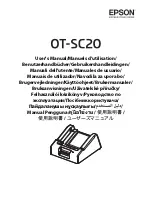
34
Discharge voltage per cell at the end of the discharge cycle
Use this setting to configure the voltage per cell at the end of the discharge cycle.
Important!
Never select a voltage that is too low. This can cause lithium batteries to overdischarge and result in per-
manent damage to the battery.
Refer to the table in section 7 or the manufacturer's specifications.
End-of-charge voltage per cell
Use this setting to configure the voltage per cell for lithium batteries at the end of the charging cycle.
Important!
Never select a voltage that is too high. In the case of lithium batteries, the battery may explode or cause a
fire!
Refer to the table in section 7 or the manufacturer's specifications.
Over-temperature protection
The charger can be set to automatically stop the charging/discharge cycle when the battery exceeds a preset tem-
perature.
An external temperature sensor is required to use this feature (not included). This must be connected to the
corresponding socket on the charger.
Trickle charge current (only for NiMH and NiCd batteries)
Use this feature to set the trickle charge current. When a NiMH or NiCd battery is fully charged, it loses some of its
capacity due to self-discharge. The trickle charge feature (short charge impulses, the charger does not deliver a
continuous current!) ensures that the battery stays fully charged and prevents crystals from forming inside the battery.
DISCHG VOLTAGE
3.0V/CELL
TVC=YOUR RISK!
4.20V
TEMPERATURE
CUT-OFF 50C
TRICKLE
100mA















































